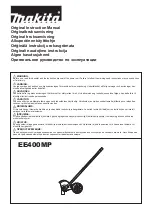
Figure 6.3
1. Activate the parking brake by pulling on the lever (A).
2. Release the parking brake by moving the lever
slightly forwards and then backwards to position (B).
3. If the machine has to be parked on or close to a public
road, the machine must also be secured with chocks
under the transport wheels.
4. If the machine is to be parked for a longer period of
time, the parking brake should be disengaged. The
machine should instead be secured with chocks.
6.1.3
Pneumatic brakes
The brakes are non self-adjusting drum brakes.
The system works using compressed air. It comprises a
pressure tank, one or more spring-loaded brake cylinders,
one brake valve with accompanying retarder valve and
two connector hoses to the tractor. The air enters the
system through a filter and is therefore free from
contaminants.
There is a built-in emergency brake that comes into effect
in the event of the machine becoming unhitched from the
tractor.
The brake system is designed for the following air
pressures:
Table 6.1
Feed pressure:
6.5 bar
Red connection
Control
coupling:
0–6.5 bar
Yellow
connection
6.1.3.1
Connecting the brakes
Connect the brake system’s compressed air line and
steering links to the tractor’s brake fittings.
When connected to the tractor, the pressure tank is filled
with compressed air. When running, the pressure tank
maintains a pressure of around 6.5 bar. The machine
brakes using the tractor’s brake pedal.
6.1.3.2
Disconnecting the brakes
Unhitching and parking must always take place
on a flat, firm surface.
Figure 6.4
1. When unhitching the machine, the service brake is
automatically engaged.
2. The cylinder switches over to the spring-loaded brake
system after the brake system has been depressurised.
This means the machine can never start to roll
unintentionally.
3. An unhitched implement with at least 5 bar in the
pressure tank can be made moveable by depressing
retarder valve A. The brakes are then released and the
machine rolls freely.
4. Reset the retarder valve (A). Otherwise there will be a
risk of the machine rolling away unintentionally.
5. If the machine is depressurised and there is no
available access to compressed air, it cannot be
moved because the spring brake system is active. The
tension on the spring must be relieved with the screw
(C,
) located at the back of the spring
brake cylinder in order to move the machine. This
screw must then be readjusted for normal operation,
otherwise there is a risk of the machine rolling away
unintentionally.
6.1.3.3
Before driving with hydraulic brakes
The pneumatic brakes are linked to the tractor’s
compressed air couplings and are controlled by the
pressure applied to the tractor brake pedal. The brake
cylinders and the length of the brake lever have been
designed to provide sufficient braking power without
locking the wheels.
Please note that the hose must only be connected to a
brake coupling that is controlled by the tractor’s brake
pedal, providing a maximum pressure of 6.5 bar.
A
B
A
20
903815-en-gb; 23.09.2021
















































